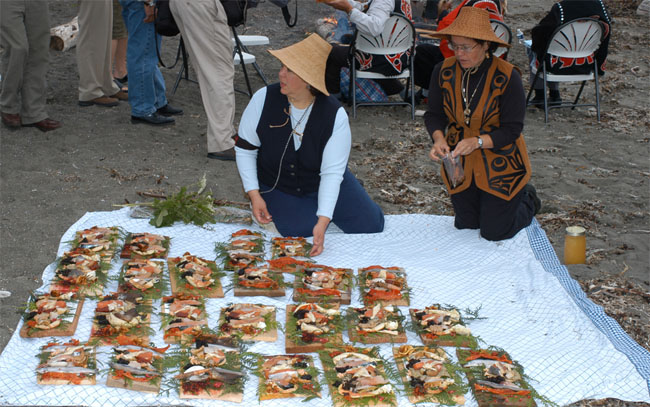Haida honour their ancestors by bringing them home

By Laurie Leclair
TORONTO – At last week’s Chiefs of Ontario Heritage and Burials Policy Forum, Jisgang Nika Collison, a member of the Ts’aahl clan of the Haida Nation spoke about the repatriation policies of the Haida.
Ms. Collison whose people live in Skidegate, informed her audience that an estimated 97% of the Haida Gwaii’s cultural treasures have been taken away by both private collectors and institutions since the nineteenth century. This aggressive thievery did not stop at material goods, but extended to taking the ancestors themselves. The remains of people were stolen from mortuary poles, pulled out of burial caves and houses or simply lifted out from above ground graves and mass burials. This large-scale theft continued relatively unnoticed, especially following the small pox epidemics of the late 1800’s. With their populations severely compromised the Haida, seeking survival and comfort in numbers, migrated away from ancestral villages to either Skidegate or Old Massett where they could band together. In the wake of these migrations ancient cemeteries and cultural monuments fell prey to collectors and other thieves.
It is both a heartbreaking and an enraging story but Ms. Collison maintained that anger, beyond its motivational powers, was unproductive. She believes that times are changing and that her community and museums can work together to correct the wrongdoings of the past and at the same time honour their ancestors. This positive sense of purpose has guided her interactions with curators and museum administrations throughout North America and Europe.
Ms. Collison is also the curator of the Haida Gwaii Museum, a part of the Haida Heritage Centre at Kay Llnagaay. For her, this museum not only works as the mechanism that allows for the protection of these repatriated treasures and artifacts, but has become part of Haida culture. This community-led institution is designed to nurture community research and education, assist in the preservation and practice of cultural knowledge and along with the old Massett Repatriation Society, work with the Council of the Haida Nation’s Haida Repatriation Committee to bring home their ancestors and cultural treasures.
The process of bringing back the ancestors has evolved from a grass roots movement by the people themselves, motivated by ethical rather than legal incentives. In turn, and in the absence of any precedent on their part, museums have been forced to rise to the challenge.
This grass roots zeitgeist is very much present in the actions of Ms. Collison’s colleague Andy Wilson who spoke about how he and his community paid respect to his Haida Gwaii Ancestors. Beginning early in his teens when his father made him walk among the poles and mossy foundations of his traditional homeland, Wilson has had a keen interest in the protection of these beautiful lands and for over thirty years has volunteered as a Haida Gwaii Watchman. While he has played an integral role in heritage conservation and repatriation he is perhaps best known for his cedar bentwood boxes.
In 2003, the return of over 160 Haida ancestors from Chicago’s Field Museum provided one of the most moving examples of the communities’ involvement in the repatriation process. When the Repatriation Committee sought advice from its elders regarding the most respectful way to conduct the return of their ancestors’ remains it was given a list of important criteria to follow: The ancestors had to be attended and spoken to throughout the move, their remains wrapped in blankets and covered in cedar. When they were ready to be reburied, their bones had to rest in bentwood boxes. Mr. Wilson took it upon himself to learn how to build and inscribe these traditional coffins, drawing inspiration from within and often inventing new construction techniques. Over the years he has made hundreds, in varying sizes and in the process has created respectful resting places for his ancestors, or Kuniisii, many of whom had been lost in sterile drawers and Hollinger boxes.
Thousands of volunteer hours went into preparing to receive the ancestors, a good part of the time spent in fundraising. The cost of sending representatives to Chicago to collect and accompany the ancestors back to Haida Territory was estimated at $100,000, the majority of which the community raised itself through feasts and merchandise sales. People from all walks of life got involved in the hands-on preparations. As bentwood boxes were inscribed with clan crests and painted by high school students, younger children crafted the button blankets and wove the cedar mats. Others practiced the sacred dances and learned the ancient songs that were needed for the burial ceremonies. As always, the elders were there to advise.
Through the efforts of the Haida Repatriation Committee and those who work alongside it, over 500 of Haida Gwaai’s ancestors – young and old, male and female have found their way back. And upon their arrival their descendants, also young and old, male and female, were there to welcome them home.


